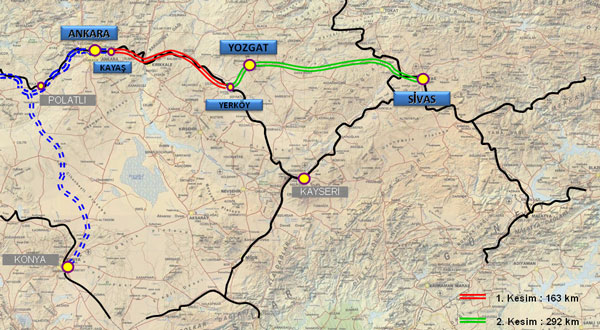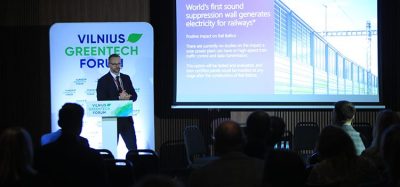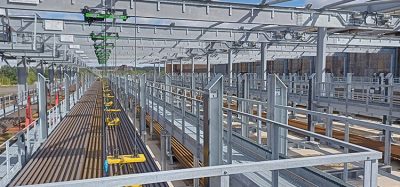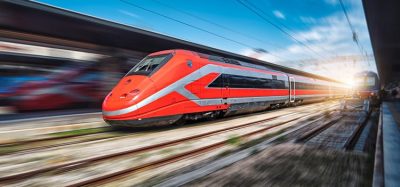Major projects keep Turkey on track
Posted: 5 April 2010 | | No comments yet
TCDD, Turkish State Railways, is forging ahead with high-speed projects and other infrastructure developments to ensure they continue to provide effective, efficient and up-to-date passenger transportation for their country.
TCDD, Turkish State Railways, is forging ahead with high-speed projects and other infrastructure developments to ensure they continue to provide effective, efficient and up-to-date passenger transportation for their country.
TCDD, Turkish State Railways, is forging ahead with high-speed projects and other infrastructure developments to ensure they continue to provide effective, efficient and up-to-date passenger transportation for their country.
The Ankara-Istanbul High-Speed Line Project
The aim of the Ankara-Istanbul High-Speed Line Project is to decrease the travel time between Ankara and Istanbul – the two major cities of Turkey, as well as increasing the railway transportation share by creating fast, comfortable and safe transportation. The total length of this double-track line will be 533km, all of which will be signalled and electrified and capable of speeds up to 250km/h.
The construction of the 206km Esenkent- Eskişehir section of this high-speed line project was completed and commissioned on 13 March 2009 and high-speed train operations were launched between Ankara and Eskişehir on 14 March 2009. With a travel speed of 250km/h, the journey time between Ankara and Eskişehir has been reduced from 1 hour and 27 minutes to 1 hour and 5 minutes.
On the other side, the travel time between Ankara and Istanbul has been reduced to 5 hours and 30 minutes since the journey is now using high-speed trains (YHT). In addition the travel time between Ankara and Kütahya via railbuses with YHT connection has been reduced to 3 hours. The distance between Ankara and Bursa has also been reduced from 6 hours to 4 hours with YHT and bus connection. Furthermore, by putting this project into practice, the travel time on the Ankara-Balıkesir-İzmir line connected with this route will also be 2 hours shorter.
The superstructure works of the Sincan- Esenkent section have been completed and testing is in progress. The infrastructure and superstructure constructions of the Eskişehir-İnönü section are proceeding at a fast pace. The construction works within the second phase – Inönü-Vezirhan and Vezirhan- Köseköy sections are also underway. Implementation projects between Köseköy and Gebze have been completed. Seventy-five percent of the grant funds from the Instrument for Pre-Accession Assistance (IPA) has been provided and a tender will also be launched.
When the project is completed, the distance between Ankara and Istanbul will be reduced from 567km to 533km and the travel time will be reduced from between 7-8 hours to around 3 hours.
Commercial operation of the high-speed train between Ankara-Eskişehir was launched on 13 March 2009 and the number of high-speed trains running was increased to 15 from 1 September 2009. Ankara-Bursa combined passenger transportation has been also launched with a YHT and bus connection.
The mentioned train sets are formed by six wagons with a capacity of 419 passengers and which travel at a speed of 250km/h. There are two types of wagons; one is business and the other is first class; the seats are placed as 2+1 in the business wagons and they are placed as 2+2 in first class wagons. Integrated TFT monitors, air conditioning, train monitoring, an announcement system and visual media systems are available in the wagons. In addition, there are also special parts designed for disabled passengers in the first class wagons.
It is required that the high-speed train station project will be a structure which will befit Ankara, and which will increase the prestige of our Ministry and Turkish State Railways (TCDD) and ensure continuity. The station will fulfill passengers’ needs completely; in addition it will be a new and attractive centre with its shopping, cafeteria, office and hotel units.
The building of the high-speed train station will be constructed by a Build-Operate-Transfer Model and is subject to awaiting approval of the Advanced Planning Board.


Route map of Ankara-İstanbul high-speed line project. The total length of the project is 533km which includes, among others, the following track sections; Ankara-Sincan (24km); Esenkent-Eskişehir (206km); Vezirhan-Köseköy (104km). 44km of the Gebze-Haydarpaşa section isn’t included in the Ankara-İstanbul High-Speed Line Project as it will be transformed into a surface metro with the Marmaray Project.
The Ankara-Konya High-Speed Line Project
The existing line between Ankara and Konya is 687km, but in stark contrast the distance by road is 258km, and this is why highway transportation is preferred. It is highly important to provide a significantly reduced journey time between Konya and Istanbul and Ankara. Therefore, plans have been made to construct the Ankara-Konya High-Speed Line Project which will provide railway transportation between Konya and Ankara, Istanbul as well as Izmir.
When completed, the travel time between Ankara-Konya will be dramatically reduced from 10 hours and 30 minutes to just 1 hour and 15 minutes and the journey time from Ankara-Istanbul will be significantly reduced from 12 hours and 25 minutes to 3 hours and 30 minutes.
The infrastructure works of the line are about to be completed and the construction works of the superstructure are in progress. It is planned to put the line into operation during 2010.


Route map of the Ankara-Konya high-speed line project. This new line will be signaled, electrified and of double-track construction- capable of speeds up to 250km/h and a total length of 306 km
The Ankara-Sivas High-Speed Line Project
The aim of this high-speed line project is to create a double-track East-West axis which will be 461km in length, fully signaled and electrified, and will reduce the travel time from 12 hours to approximately 3 hours.
The foundation of the 287km Yerköy-Sivas section, planned to be constructed within the first phase, was laid on 14 March 2009 and the infrastructure works are currently in progress. The tender works for the implementation projects of the 174km section between Ankara (Kayaş) and Yerköy (with the purpose of maintaining the existing line and revising the project to raise the standards of the track geometry) are to be completed.
Marmaray Project consists of four main groups This project, with a capacity of carrying 75,000 passengers one way, and carrying 1 million passengers every day, will reduce travel time between the two sides of the Strait to 4 minutes, and connect Asian-European continents by railway under the sea. It is environment friendly and will be integrated in other transportation systems; it will also increase the share of railway transportation in public transport in Istanbul from 6.4% to 27.7%.
The Marmaray Project is 76.3km in length and consists of the following four main groups:
- Engineering and consultancy services
- The Istanbul Strait rail tube tunnel crossing (BC-1)
- Rehabilitation of commuter lines (CR-1)
- Rolling stocks (CR-2)
The cost of all system amounts to approximately 3 billion USD. The Marmaray Project tendered through the ‘Design/Build Turnkey’ model is in progress; the foundation of ‘The Strait Rail Tube Tunnel Crossing Construction’ section of the project was laid on 9 May 2004 and works began.


Route map of the Ankara-Sivas high-speed line which will have a design speed of up to 250 km/h and includes 36 bridges and seven tunnels. When completed, the route will offer considerably reduced travel times.
The works in progress within the scope of the BC1 Contract
Within the scope of construction, archeological digs have been completed in Yedikule and Üsküdar and construction has been launched; the construction works are still in progress at the Üsküdar and Sirkeci Station sites with TBM4 and TBM5 tunnel boring machines. Through these works, many historical artifacts have been unearthed which illuminate the history of Istanbul. It has contributed to the cultural heritage of the city; however delays in the construction of the project have occurred.
The archeological digs of 1,136,000 cubic meters have been carried out on the ground where the immersed tube tunnel will be placed. The works for totally immersing 11 tunnels, of which the deepest one is 60m in depth, were launched on 24 March 2007 and completed on 23 September 2008 – earlier than the expected time.
Approximately 4,600m of the 20,088m land tunnels have been dug on three different points with tunnel boring machines (TBM). 127.2m of the Üsküdar Switch Tunnel has been bored and completed using the New Austrian Tunneling Method (NATM).
The work of the CR-1 Contract:
The contract of the tender on The Work of Rehabilitation of Commuter Lines and The Electromechanic Systems (CR-1), the second part of the project, has been signed and construction site delivery was made on 21 June 2007 and work began.
Within the scope of work to be carried out, 36 stations will be renewed and turned into modern stations on the condition that the historical ones will be restored; anti-noise panels will be used at the required parts throughout the line; the number of existing lines will be increased from two to three and one of the lines will be used by main line passenger and freight trains. The travel time between Kazlıçeşme and Söğütlüçeşme will be 18 minutes; it will be 105 minutes between Gebze and Halkalı.
On the line, 30 existing bridges will be preserved and 21 new bridges will be constructed; 157 art structures (pedestrian underground-overpass and culvert) will be demolished and rebuilt. Primary design and drilling works are in progress. The removal of the fill at Gebze Station and Depot site is underway; a culvert has been dug and concrete casting for foundation has been completed.
The work of the CR-2 Contract:
Within the scope of CR-2 project, tenders were released for the procurement of 440 rolling stock units, 22-23m in length. A contract was signed with HYUNDAI ROTEM Company, the winner of the tender on 10 November 2008. The works on the design of the rolling stock are ongoing. The Marmaray Project will also be integrated in the rail systems made by the Istanbul Metropolitan Municipality and works will be carried out in such a way so that the connection between Atatürk and Sabiha Gökçen Airports is provided.
About the author
Süleyman Karaman graduated from the Mechanical Engineering Faculty of Istanbul Technical University (ITU) in 1978. In 1981 he took his master degree in the same university and he received a Mechanical Engineer MSc title with high degree. Following this, Mr. Karaman carried out some studies concerning farming machinery, took up a short-term military post and worked for a private automotive company. Then in 1994 he was appointed as Deputy Director General of IETT (Istanbul Public Transport Authority) where he took part in many projects, one of which was the implementation of Smart Tickets. In 2001, he first became Director General of TCDD until 2004 – but returned to the position in 2005







